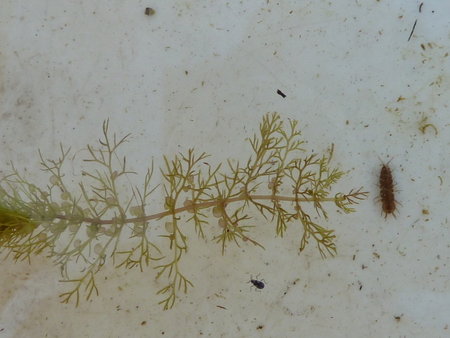
Good Natured: Carnivorous Bladderwort
Mention the word carnivore and folks tend to picture creatures known for their meat-eating ways. Lions and tigers and bears (though the latter actually are omnivores). Tyrannosaurus rex. Genghis Khan.
Carnivorous plants, however, are a whole other matter. If you ask someone who's not a botanist to name three different types I bet they'll stop after two: Venus flytraps and pitcher plants. (Audrey II, the bloodthirsty plant in Little Shop of Horrors, doesn't count.)
Within the botany world, carnivory is considered a narrow specialty. In the estimated (because nobody really knows for sure) 435,000 plant species in the world, 750-ish have been identified as carnivorous. If you're into math, or money, 750/435,000 is 0.17%, the same percentage as .17/100, or 17 cents out of $100.
Put yet another way, that's not a lot.
Why is that, you ask? Well, to begin with, let's look at what the other $99.83 worth of plants need to survive. Most of those require sunlight, moisture and nutrient-rich soils containing nitrogen, phosphorus and potassium—the N-P-K symbols on fertilizers you buy for your lawn and houseplants. But not every environment is able to offer those ideal conditions.
Bogs, characterized by an acidic pH, and fens, which are alkaline, provide plants with lots of water and sunlight, but often have soil that is low in nutrients. Plants in these specific types of ecosystems have had to get creative, so to speak, in how they receive their sustenance.
Some went the route of carnivory. Their leaves are modified into snap traps, pitfall traps or sticky traps, to name a few, and these adaptations allow them to consume prey that, depending on what the plant is and where it lives, can range from microbes to insects to vertebrates like small mammals.
If you've ever traveled to Volo Bog, a really neat IL State Natural Area about an hour north of St. Charles, you've probably seen carnivorous pitcher plants. Small but fascinating, these special plants merit their own stop on the bog's self-guided tour maps. You might also recall reading about round-leaved sundew. It once grew in the bog and used its sticky tentacles to capture insect prey. Alas, so alluring was this plant and its unique adaptations that it was collected into oblivion—by botany students, no less--and no longer grows there.
But Volo Bog isn't the only place in Illinois to feature carnivorous plants. Nope, we have some right here in Kane County. Only thing is, you might need to get your feet wet to see them.
Bladderworts (Utricularia spp.) are fully aquatic plants that can be found in select wetlands throughout our region, including our own Hickory Knolls Natural Area in St. Charles. Famed naturalist Dick Young, in his book Wild Plants and Natural Areas of Kane County, lists two species, U. vulgaris or great (today called common) bladderwort and U. intermedia, flat-leaved bladderwort. Both feature yellow, snapdragon-like flowers that push above the water's surface and their namesake bladder-covered segments below.
Unlike pitcher plants and sundews, which do their insect capturing in plain sight, bladderworts take in aquatic organisms inconspicuously using—you guessed it—their bladders. These little structures, which look like tiny translucent balloons on the plant's submerged stems, have microscopic hairlike projections (known as utrica, hence the genus name) on one end. These trigger hairs surround an opening on the bladder's surface. When a small arthropod like, say, a daphnia, swims near, the ripples it creates stimulate the hairs, which then cause the bladder to open. Water, and the hapless bug, are sucked into the void and trapped when the bladder's opening shuts. The victim quickly expires, and the plant then absorbs the nutrients released during the resulting decomposition.
The whole process is aided by a host of other tiny organisms that live on the plant and coat its finely divided leaves. These bacteria, diatoms and blue-green algae—collectively known as perphyton—are just the sort of thing that small creatures, like daphnia, feed on. Lured in by the promise of a meal, they bump into the trigger hairs and, pop! The would-be consumers are instead consumed.
The next time you find yourself participating in a conversation in carnivory, you might want to try spicing things up a bit. Not with talk of meat-eating dinosaurs or even humans with high protein requirements. But rather lions and tigers and…bladderwort.
Pam Otto is the outreach ambassador for the St. Charles Park District. She can be reached at potto@stcparks.org.

